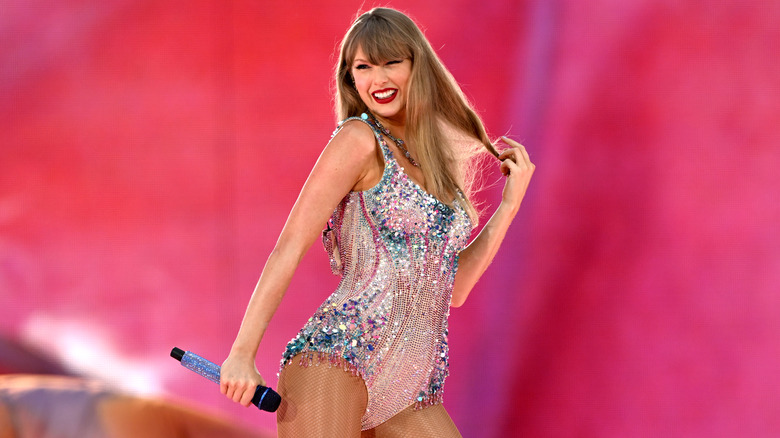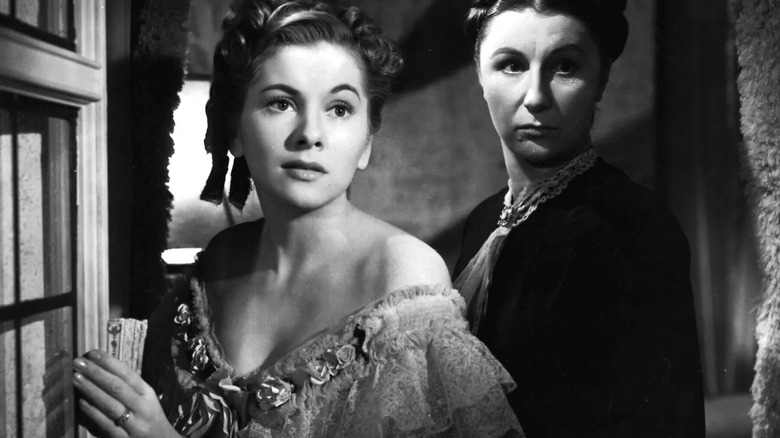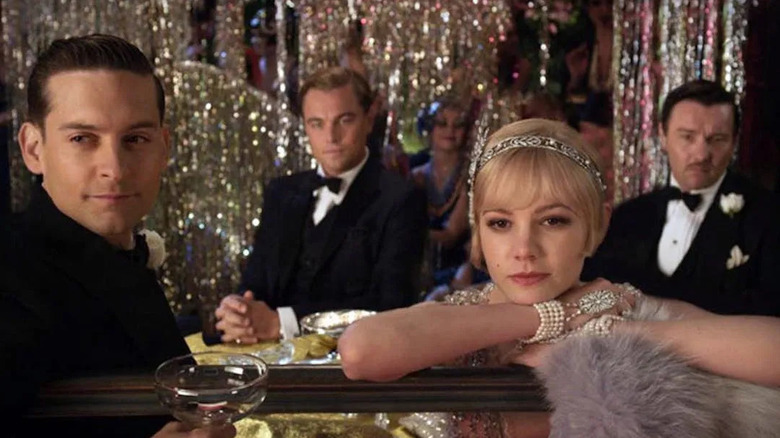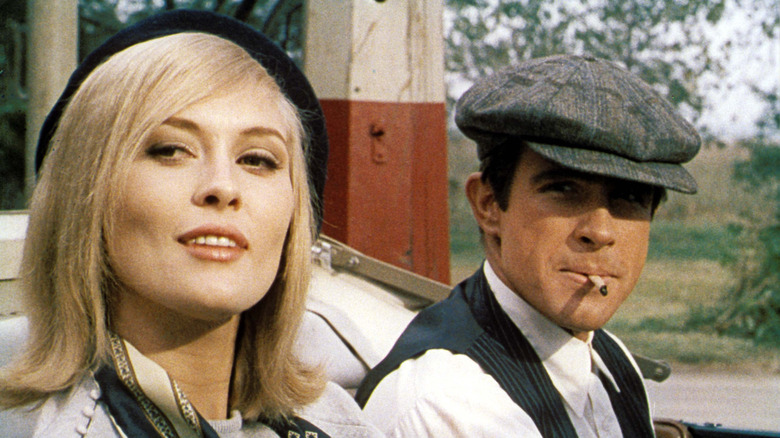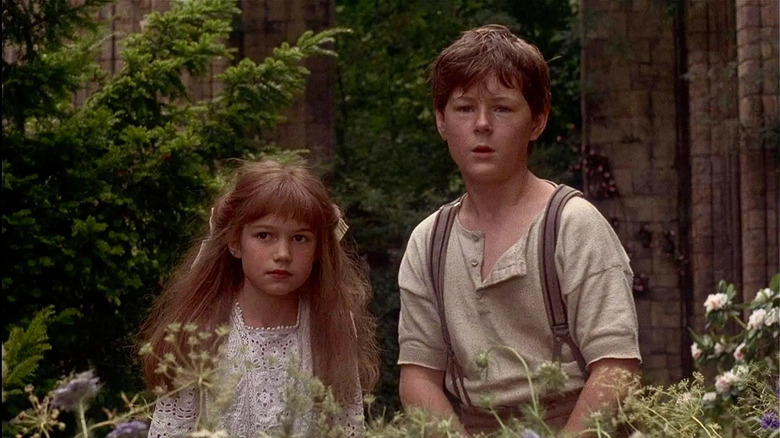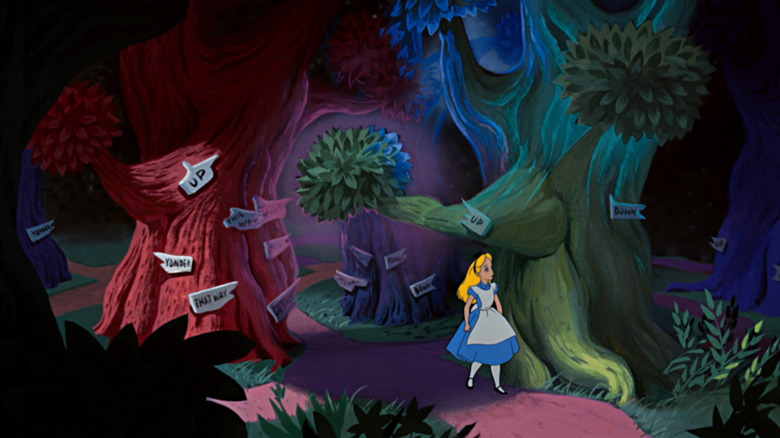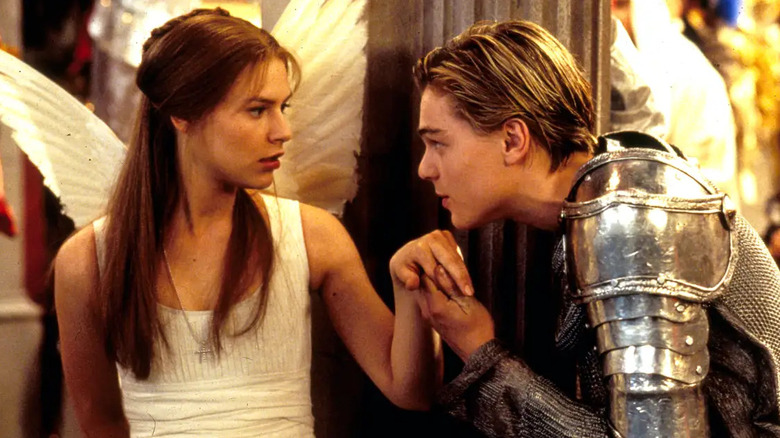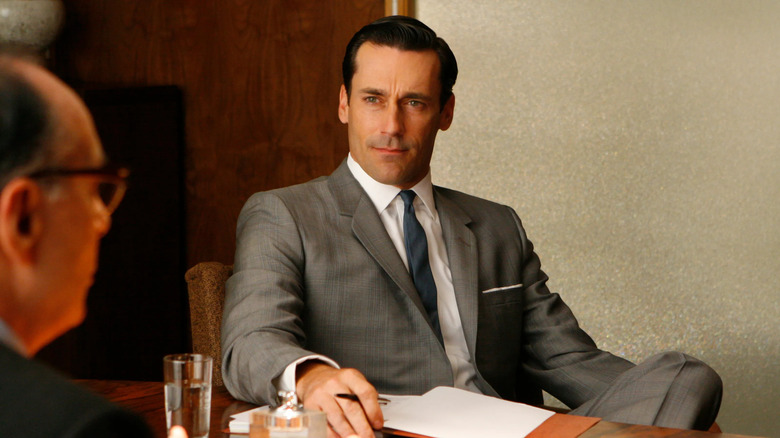If you think Taylor Swift only churns out bubblegum pop music for young audiences, think again. The singer-songwriter turned global superstar, who’s been working steadily and fearlessly in the music industry since she was a teenager — her first album, simply titled “Taylor Swift,” dropped in 2006 and she never really slowed down after that — is a wordsmith. Don’t take our word for it; critics have compared her to great poets like Emily Dickinson (to whom Swift is distantly related), and songwriters like Carole King, Stevie Nicks, and Paul McCartney have lavished praise upon Swift for her songwriting technique.
It’s one thing to have a way with words, as Swift certainly does; look to lyrics like “You made a rebel of a careless man’s careful daughter” or “You called me up again just to break me like a promise / So casually cruel in the name of being honest” as just two examples. It’s another entirely to weave subtle (and, frankly, obvious) references to novels, TV shows, and films into your song in ways that some listeners might not even notice. If you think you’ve caught every pop culture reference in Swift’s music, think again — and we’re not including ones here like her song “Death by a Thousand Cuts” from “Lover,” which was based on a movie (Jennifer Kaytin Robinson’s “Someone Great,” which itself was based on Swift’s breakup anthem “Clean” from “1989”). From highbrow Hitchcock classics to movies apparently beloved by her boyfriend Travis Kelce — a newly minted film star in his own right — here are movies and TV shows referenced in Taylor Swift songs … and by the by, none of them are movies or shows she’s appeared in herself.
Rebecca
Based on Daphne du Maurier’s 1938 novel of the same name, Alfred Hitchcock’s only Oscar winner for best picture, “Rebecca,” is the story of a young, unnamed woman (Joan Fontaine) who, after a whirlwind romance in Europe, marries the enigmatic, mysterious, and very wealthy widow Maxim de Winter (Laurence Olivier). When they head to his estate in England, named Manderley, Maxim becomes a different person to the woman now known as the “second Mrs. de Winter,” constantly judging her against the ghost of his dead, unseen wife Rebecca and treating his second wife coldly. None of this is helped by Manderley’s often cruel housekeeper Mrs. Danvers (a terrifying Judith Anderson), and ultimately, the second Mrs. de Winter has to try and understand what happened to her predecessor.
After being named Apple Music’s Songwriter of the Year, Swift spoke to Zane Lowe and opened up about her inspiration for specific songs on “evermore,” and apparently, “Rebecca” helped her come up with the idea for “tolerate it,” one of the album’s most devastating tracks. “When I was reading Rebecca by Daphne Du Maurier, I was thinking, ‘Wow, her husband just tolerates her,'” Swift mused. “‘She’s doing all these things and she’s trying so hard and she’s trying to impress him and he’s just tolerating her the whole time.'” There was a part of me that was relating to that, because at some point in my life, I felt that way.” Reading or watching “Rebecca” is heartbreaking enough, which is probably where Swift came up with one of her most gutting bridges of all time:
“While you were out buildin’ other worlds, where was I?
Where’s that man who’d throw blankets over my barbed wire?
I made you my temple, my mural, my sky
Now I’m beggin’ for footnotes in the story of your life.”
“tolerate it” — a part of Swift’s grand tradition of reserving each album’s most stomach-twisting song for the fifth track — is astounding, and so is Hitchcock’s “Rebecca.” Just one word of advice: ignore the 2020 Netflix remake.
The Great Gatsby
Based on her obvious love of classic literature, it’s not all that surprising that Taylor Swift references F. Scott Fitzgerald’s “The Great Gatsby” in a handful of songs (which was made into a handful of films, including one in 2013 by Baz Lurhmann starring Leonardo DiCaprio and Carey Mulligan). In case you skipped this book in high school, here’s a quick refresher. Outsider Nick Carraway (Tobey Maguire in Luhrmann’s film) meets the hard-partying, obscenely wealthy Long Island bachelor Jay Gatsby (DiCaprio), who’s been carrying a torch for beautiful socialite Daisy Buchanan (Mulligan) for years to the point where he basically constructs his West Egg mansion to get her attention. So how and when does “Gatsby” figure into Swift’s songs?
The clearest allusion, if you can call it that, is in “This is Why We Can’t Have Nice Things” on “reputation” — largely seen as a diss track directed at Ye (née Kanye West) and his ex-wife Kim Kardashian — where Swift says she and her friends were “feelin’ so Gatsby for that whole year.” Beyond that, in the song “happiness” on “evermore,” Swift hopes her former lover’s next flame will be a “beautiful fool,” which is a phrase often tossed around by Daisy. You can also regard one line from the “reputation” rock ballad “Don’t Blame Me” — “I was poison ivy, but now I’m your daisy” — as a “Gatsby” reference, but that might be a stretch.
Bonnie & Clyde
People often accuse Taylor Swift of only writing songs about her ex-boyfriends, which, frankly, is patently unfair (have those critics listened to “The Best Day” about her mother, “The Archer” about her own anxiety, or “epiphany” about World War II and the COVID-19 pandemic?!) Still, “Getaway Car” from “reputation” is about an ex-boyfriend — Swift never clears up which song is about whom, but this one might be about her short-lived fling with Marvel star Tom Hiddleston — and before we get to her reference to Arthur Penn’s 1967 film “Bonnie & Clyde,” Swift gives a shoutout to Charles Dickens’ “A Tale of Two Cities” with her opening line: “It was the best of times, the worst of crimes.”
“We were jet-set, Bonnie and Clyde (oh-oh)
Until I switched to the other side, to the other side
It’s no surprise I turned you in (oh-oh)
‘Cause us traitors never win.”
You’ll notice, throughout this list, that Swift sometimes tweaks fiction to suit the themes of her song — so it’s important to note that if we’re seeing Swift as Bonnie Parker and Hiddleston as Clyde Barrow, Bonnie never turned Clyde in. In real life, as in Penn’s film — which casts Faye Dunaway as Bonnie and Warren Beatty as Clyde — the criminal couple ended up apprehended by police and killed. Still, if you’re a “Getaway Car” stan, definitely check out “Bonnie & Clyde.”
The Secret Garden
Frances Hodgson Burnett’s 1911 book “The Secret Garden” has been adapted into many films since its release well over a century ago, but considering the fact that Taylor Swift was quite famously born in 1989, she probably watched the 1993 adaptation like the rest of her millennial cohorts. That movie, helmed by legendary Polish director Agnieszka Holland, stars Kate Maberly as Mary Lennox, an orphaned young girl who ends up living with her uncle, Lord Archibald Craven (John Lynch), after her parents are killed in an earthquake in the imperially controlled India. On Archibald’s massive estate, Mary and Dickon Sowerby (Andrew Knott) — the younger brother of Mary’s maid Martha (Laura Crossley) — discover a secret and walled-off garden. Using a mysterious key she found in the house, Mary unlocks the garden, which becomes an oasis for her and Dickon as they clean it up together.
So when does Swift reference this song? In the track “I Hate It Here” — which can be found on “The Anthology,” the surprise sister album that dropped simultaneously with Swift’s April 2024 hit “The Tortured Poets Department” — Swift, after jokingly asking a paramour to tell her something “awful” like he’s a “poet trapped inside the body of a finance guy,” she segues into the chorus. It goes:
“I hate it here so I will go to
secret gardens in my mind
People need a key to get to
The only one is mine
I read about it in a book when I was a precocious child”
In “The Secret Garden,” the titular space is an oasis that helps the Craven family find themselves again — and clearly, Swift views her mental garden as the same kind of safe space. No wonder she mentioned it in one of her most emotionally complex albums.
Who’s Afraid of Virginia Woolf?
Directed by the great Mike Nichols in his directorial debut, 1966’s “Who’s Afraid of Virginia Woolf?” — based on Edward Albee’s famous play of the same name — is one of two films, besides the 1931 Western movie “Cimarron,” to earn a nomination in every eligible category at the Academy Awards. (Appropriately, the movie earned 13 nominations, and 13 is, quite famously, Taylor Swift’s lucky number.) With that in mind, how does she mention “Who’s Afraid of Virginia Woolf?”
Nichols’ film features Elizabeth Taylor and Richard Burton, then a real-life couple — who spent plenty of time on tabloid covers, something with which Swift is quite familiar — as Martha and George, married people who make a habit of inviting others over for double dates and committing light-to-heavy emotional and mental terrorism. (There’s no other way, really, to describe the plot of this play and film.) Swift’s first mention of the infamous duo comes in “Ready For It…?” on “reputation,” where she tells her lover, “You can be my jailer / Burton to this Taylor,” playing on her and the actress’ shared name. On “The Tortured Poets Department,” though, Swift makes a much clearer reference in the song titled “Who’s Afraid of Little Old Me?”
In the chorus, which reflects Swift’s upbringing in the public eye (“You wouldn’t last an hour in the asylum where they raised me”), Swift sings:
“So I leap from the gallows and I levitate down your street
Crash the party like a record scratch as I scream
‘Who’s afraid of little old me?’
You should be”
Swift’s song doesn’t focus on the complexities of relationships and marriages that we see in “Who’s Afraid of Virginia Woolf” — but using the film’s titular question to talk about her own experiences is pretty brilliant.
Alice in Wonderland
Lewis Carroll’s children’s novels “Alice’s Adventures in Wonderland” and “Through the Looking Glass” have become some of the most famous texts in the literary canon since they came out in the 1800s, so it’s not a huge surprise that Taylor Swift felt inspired by at least one of its adaptations. Because Tim Burton’s live-action adaptations are so recent, like we did with “The Secret Garden,” we can probably assume that she took said inspiration from the animated Disney classic that came out in 1951. Pretty much everyone knows the basics of Alice’s famous adventures, who which Swift songs mention the blonde heroine who travels through fantastical worlds?
In the chorus of the bonus track “Long Story Short” from “evermore,” Swift repeatedly notes that she “fell from the pedestal, right down a rabbit hole,” but obviously, the bulk of her “Alice” references can be found in the song “Wonderland” on “1989” (which also happens to be a bonus track, strangely enough). In the chorus, Swift sings about how she and the object of her affection “found Wonderland” and “got lost in it,” and at the beginning of the song, she references falling down the “rabbit hole” for the first time in the discography. The clearest allusion besides the title, though, comes in the pre-chorus:
Didn’t they tell us ‘Don’t rush into things?’
Didn’t you flash your green eyes at me?
Didn’t you calm my fears with a Cheshire cat smile?
This song may or may not be about Harry Styles, arguably the biggest muse on “1989” and who happens to have green eyes … but in any case, a storyteller like Swift was drawn to the world of “Alice in Wonderland” for pretty obvious reasons.
Peter Pan
At the risk of editorializing, anyone who has even a passing familiarity with Taylor Swift’s discography knows she needs to stop falling in love with men who aren’t ready to grow up. In the years before she met the (seemingly and surprisingly emotionally mature) football player Travis Kelce, Swift brought up the “boy who never grew up,” Peter Pan himself, in quite a few songs. In the striking single “cardigan” from her Album of the Year winner (and first pandemic album), “folklore,” Swift croons:
“I knew you
Tried to change the ending
Peter losing Wendy”
You can also read some of Swift’s “Peter Pan” references as that the star feels as if she’s also been frozen in time, whether that’s about her public perception or her longings for lost loves. Nowhere is this clearer than on “Peter,” one of the final tracks of “The Anthology.” The entire song is about the famous lost boy Peter Pan, with the chorus pleading, “You said you were gonna grow up, then you were gonna come find me.” After singing that she waited for the titular Peter for as long as she could while he was “Lost to the Lost Boys chapter” of his life, Swift concludes:
“Forgive me, Peter, please know that I tried
To hold on (hold on) to the days (to the days)
When you were mine
But the woman who sits by the window has turned out the light”
Painting herself as Wendy throughout, Swift creates a vivid tableau: that of a woman desperately hoping the man she loves will give her what she wants and needs, only to watch him fall short and fly away every time.
Romeo + Juliet
Of course a teenage Taylor Swift used one of the most famous love stories ever told for her “Fearless” single and massive hit, “Love Story.” The thing is, she really changes up the plot of William Shakespeare’s tragedy, which was made into several movies (including another Baz Luhrmann adaptation, “Romeo + Juliet,” which cast Leonardo DiCaprio and Claire Danes as the star-crossed lovers). In “Love Story,” which is still one of Swift’s biggest songs — and was prominently featured in the “Fearless” set on Swift’s massive Eras Tour — Romeo and Juliet fall in love, with Swift singing about Romeo “throwing pebbles” and her “daddy” insisting that Romeo “stay away from Juliet. In the chorus, Swift sings:
“Romeo, take me somewhere we can be alone
I’ll be waiting, all there’s left to do is run
You’ll be the prince and I’ll be the princess
It’s a love story, baby, just say, ‘Yes’
Romeo, save me, they’re tryna tell me how to feel
This love is difficult, but it’s real
Don’t be afraid, we’ll make it out of this mess
It’s a love story, baby, just say, ‘Yes'”
Romeo and Juliet get married in every adaptation of Shakespeare’s play, but they pretty famously elope to evade their parents and then die; in Swift’s song, the lovers live, marry, and thrive. That’s okay, though. A teenaged Swift can dream.
American Pie
Bet you didn’t expect to see the 1999 sex comedy “American Pie” on this list, huh? Well, Taylor Swift contains multitudes. Another song featured on “The Anthology,” titled “So High School,” sure seems to be about Swift’s relationship with Kansas City Chiefs tight end Travis Kelce, from the way that they fell in love in the “blink of a crinkling eye” to when she insists that he do an impression of his dad, Ed Kelce, again. So where does “American Pie,” a movie about horned-up high schoolers trying to sleep with each other before graduation?
Well, it’s a bit naughty, especially for Swift (whose dirty references are typically subtler than this). In the song’s chorus, Swift croons:
I’m watchin’ American Pie with you on a Saturday night
Your friends are around, so be quiet
I’m tryin’ to stifle my sighs
‘Cause I feel so high school every time I look at you
But look at you
Swift and Kelce, who are still happily dating as of this writing, seemed enamored with each other right from the start, and “So High School” makes that quite clear. Good for them — and “American Pie,” one of their date-night flicks!
Mad Men
The opening track of Taylor Swift’s record-breaking fourth Grammy winner for Album of the Year, 2022’s “Midnights,” is titled “Lavender Haze” — and it drops the listener into a story of a woman desperately trying to keep her relationship away from scrutiny. (This relationship, to backtrack a bit, was likely Swift’s union of six years with British actor Joe Alwyn). In the lead-up to the album’s release, Swift shared song titles on Instagram, and apparently, the term came from the celebrated AMC series “Mad Men,” which starred Jon Hamm as duplicitous advertising executive Don Draper.
“I happened upon the phrase ‘lavender haze’ when I was watching ‘Mad Men,'” Swift said in a since-deleted Instagram story (via Rolling Stone), referencing a scene where Don’s close friend Anna (Melinda Page Hamilton) realizes he’s deeply in love. “And I looked it up because I thought it sounded cool, and it turns out that it’s a common phrase used in the ’50s where they would just describe being in love. Like, if you were in the lavender haze, then that meant that you were in that all-encompassing love glow – and I thought that was really beautiful.” Swift continued:
“And I guess, theoretically, when you’re in the ‘Lavender Haze,’ you’ll do anything to stay there and not let people bring you down off of that cloud,” And I think a lot of people have to deal with this now – not just, like, quote-unquote public figures – because we live in the era of social media and if the world finds out that you’re in love with somebody, they’re gonna weigh in on it.”
You can stream Swift’s discography on Spotify, Amazon Music, Apple Music, or wherever you listen to your favorite tunes.

